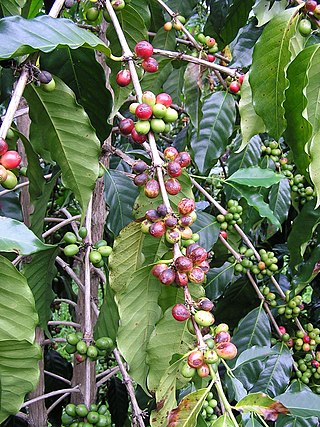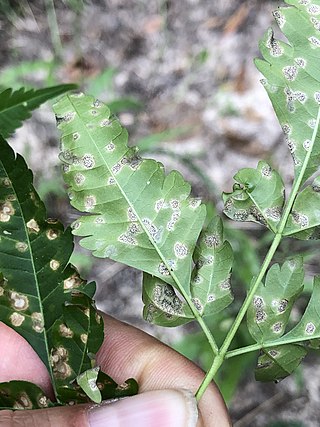
A leaf spot is a limited, discoloured, diseased area of a leaf that is caused by fungal, bacterial or viral plant diseases, or by injuries from nematodes, insects, environmental factors, toxicity or herbicides. These discoloured spots or lesions often have a centre of necrosis. Symptoms can overlap across causal agents, however differing signs and symptoms of certain pathogens can lead to the diagnosis of the type of leaf spot disease. Prolonged wet and humid conditions promote leaf spot disease and most pathogens are spread by wind, splashing rain or irrigation that carry the disease to other leaves.

Cercospora is a genus of ascomycete fungi. Most species have no known sexual stage, and when the sexual stage is identified, it is in the genus Mycosphaerella. Most species of this genus cause plant diseases, and form leaf spots. It is a relatively well-studied genus of fungi, but there are countless species not yet described, and there is still much to learn about the best-known members of the genus.

Lagerstroemia indica, the crape myrtle is a species of flowering plant in the genus Lagerstroemia of the family Lythraceae. It is native to the sub-tropical regions of the Himalayas and northern India, also to Southeast Asia, and southern China. The genus name honors Swedish botanist Magnus von Lagerström. It is an often multi-stemmed, deciduous tree with a wide spreading, flat topped, rounded, or even spike shaped open habit. The tree is a popular nesting shrub for songbirds and wrens.

Mycosphaerella coffeicola is a sexually reproducing fungal plant pathogen. It is most commonly referred to as the asexual organism Cercospora coffeicola.
Cercospora arachidicola is a fungal ascomycete plant pathogen that causes early leaf spot of peanut. Peanuts originated in South America and are cultivated globally in warm, temperate and tropical regions.

Cercospora beticola is a fungal plant pathogen which typically infects plants of the genus Beta, within the family of Chenopodiaceae. It is the cause of Cercospora leaf spot disease in sugar beets, spinach and swiss chard. Of these hosts, Cercospora leaf spot is the most economically impactful in sugar beets. Cercospora beticola is a deuteromycete fungus that reproduces using conidia. There is no teleomorph stage. C. beticola is a necrotrophic fungus that uses phytotoxins specifically Cercospora beticola toxin (CBT) to kill infected plants. CBT causes the leaf spot symptom and prevents root formation. Yield losses from Cercospora leaf spot are around 20 percent.
Cercospora rubrotincta is a fungal plant pathogen. It can cause leaf spot in stone fruits.
Mycosphaerella cruenta, also called Pseudocercosopora cruenta in its asexual stage, is a fungal plant pathogen belonging to the group Ascomycota. It can affect several legume plants, including species of Phaseolus, Vigna, Calopogonium, Lablab niger, Mucuna and Stizolobium deeringianum [Mucuna pruriens][2]. It causes cowpea cercospora leaf spot, one of the most widespread and significant plant diseases in Africa and Asia. A city in China reported a 100% Mycosphaerella cruenta infection rate on cowpea in 2014[5]. In Africa, an epidemic can cause a yield loss of up to 40% [3].
Pseudocercospora purpurea is a fungal plant pathogen that causes a leaf spot on the avocado. Species Cercospora purpurea was originally found on the leaves of Persea species in Georgia, USA in 1878. before the species was transferred to the Pseudocercospora genus in 1976.

Pseudocercospora subsessilis is a fungal plant pathogen infecting chinaberry tree. It is widespread in tropical and subtropical areas on host species of the genera Azadirachta and Swietenia.
Septoria platanifolia is a fungal plant pathogen infecting plane trees. It produces brown, circular spots that go on to develop grey centres with a darker halo.
Sphaerulina oryzina is a fungal plant pathogen infecting rice. Propiconazole is an effective fungicide recommended for use in rice culture.
Cercospora rhapidicola is a fungal plant pathogen.
Cercospora kikuchii is a fungal plant pathogen that affects soybeans. It results in both the Cercospora leaf blight and purple seed stain diseases on soybean and is found almost worldwide. C. kikuchii produces the toxin cercosporin, as do a number of other Cercospora species.
Cercospora halstedii is a fungal plant pathogen.
Cercospora hayi is a fungal plant pathogen. It can cause the brown spot disease in bananas.

Cercospora melongenae is a fungal plant pathogen that causes leaf spot on eggplant. It is a deuteromycete fungus that is primarily confined to eggplant species. Some other host species are Solanum aethiopicum and Solanum incanum. This plant pathogen only attacks leaves of eggplants and not the fruit. It is fairly common among the fungi that infect community gardens and home gardens of eggplant. Generally speaking, Cercospora melongenae attacks all local varieties of eggplants, but is most severe on the Philippine eggplant and less parasitic on a Siamese variety.

Ultra-low volume (ULV) application of pesticides has been defined as spraying at a Volume Application Rate (VAR) of less than 5 L/ha for field crops or less than 50 L/ha for tree/bush crops. VARs of 0.25 – 2 L/ha are typical for aerial ULV application to forest or migratory pests. In order to maintain efficacy at such low rates, droplet size must be rigorously controlled in order to minimise waste: this is Controlled Droplet Application (CDA). Although often designed for non-evaporative formulations, ULV equipment may sometimes be adapted for use with water, often at Very Low volume VAR.

Grey leaf spot (GLS) is a foliar fungal disease that affects maize, also known as corn. GLS is considered one of the most significant yield-limiting diseases of corn worldwide. There are two fungal pathogens that cause GLS: Cercospora zeae-maydis and Cercospora zeina. Symptoms seen on corn include leaf lesions, discoloration (chlorosis), and foliar blight. Distinct symptoms of GLS are rectangular, brown to gray necrotic lesions that run parallel to the leaf, spanning the spaces between the secondary leaf veins. The fungus survives in the debris of topsoil and infects healthy crops via asexual spores called conidia. Environmental conditions that best suit infection and growth include moist, humid, and warm climates. Poor airflow, low sunlight, overcrowding, improper soil nutrient and irrigation management, and poor soil drainage can all contribute to the propagation of the disease. Management techniques include crop resistance, crop rotation, residue management, use of fungicides, and weed control. The purpose of disease management is to prevent the amount of secondary disease cycles as well as to protect leaf area from damage prior to grain formation. Corn grey leaf spot is an important disease of corn production in the United States, economically significant throughout the Midwest and Mid-Atlantic regions. However, it is also prevalent in Africa, Central America, China, Europe, India, Mexico, the Philippines, northern South America, and Southeast Asia. The teleomorph of Cercospora zeae-maydis is assumed to be Mycosphaerella sp.

Ascolano is a cold-hardy table variety olive cultivar from the Marche and Tuscany regions of Italy that is also grown in California for olive oil.









